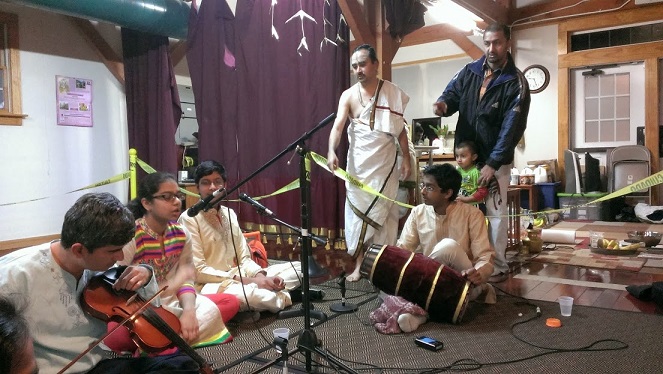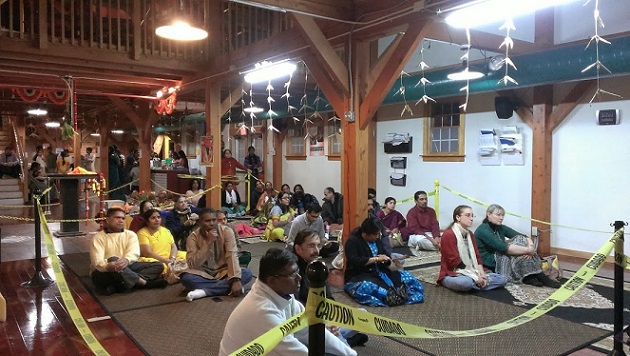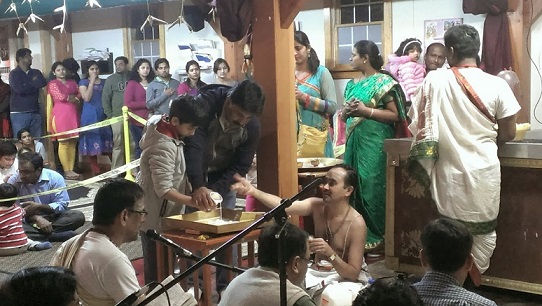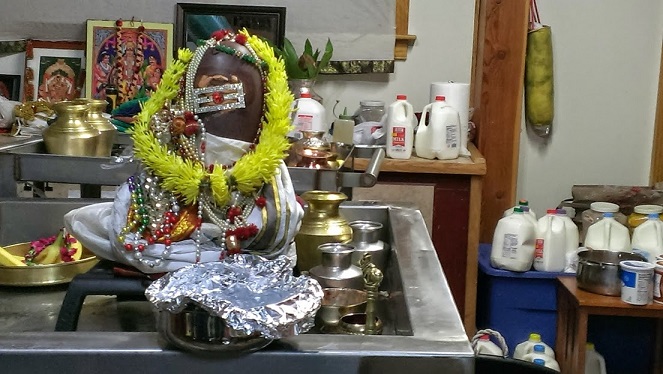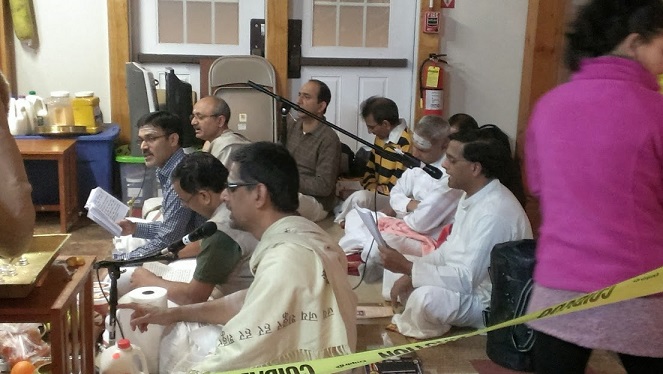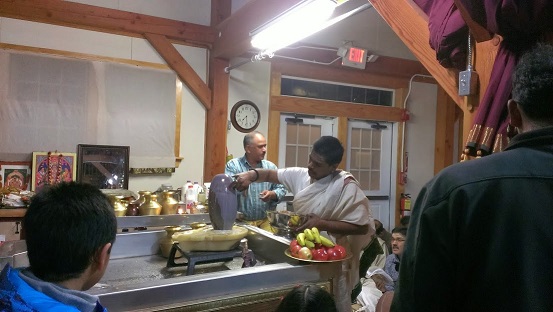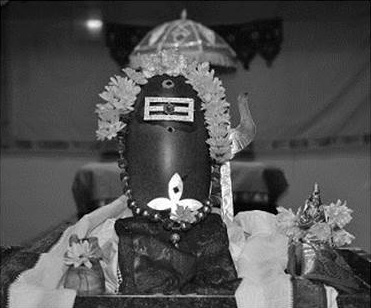Contribute
| Maha Shivaratri 2015 At The Hindu Temple Of New Hampshire |
K. Arvind
02/24/2015
Maha Shivaratri 2015 at the Hindu Temple of New Hampshire बà¥à¤°à¤¹à¥à¤®à¤®à¥à¤°à¤¾à¤°à¤¿à¤¸à¥à¤°à¤¾à¤°à¥à¤šà¤¿à¤¤à¤²à¤¿à¤™à¥à¤—मॠनिरà¥à¤®à¤²à¤à¤¾à¤¸à¤¿à¤¤à¤¶à¥‹à¤à¤¿à¤¤à¤²à¤¿à¤™à¥à¤—मॠ। brahma muraari suraarchita lingam, nirmala bhasita shobita lingam | I bow before the eternal Shiva, in the form of The Sanskrit word “Himalaya†means abode of the snow, and the Himalayas are also considered the abode of Lord Shiva. The epic blizzards of this year’s winter that have dumped more than seven feet of snow in a span of just three weeks, have transformed Boston into a Himalaya. As the Hindu Temple of New Hampshire celebrated Maha Shivaratri on Tuesday, February 17, 2015, devotees driving into the Temple were greeted with mini-mountains of snow everywhere, making their visit to the Temple a mini-pilgrimage into another Himalayan abode of Lord Shiva on this side of the world! Celebrations at the Temple The Hindu Temple of New Hampshire has been celebrating the auspicious annual occasion of Maha Shivaratri in a grand manner every year since its inception. The snow storms of this winter seemed to have little impact on the celebration this year. The usual crowds thronged the Temple for several hours that evening, with a number of devotees staying through the night observing the sacred vigil with prayers and music. The Temple also organized a Maharudram, in which the powerful and enthralling Vedic mantras from “Sri Rudram†were chanted by Ritwiks more than a thousand times over several days. The Maharudram was held during the two weekends that preceded Maha Shivaratri, and in spite of the weather, attracted numerous Ritwik volunteer participants in the area who are familiar with the nuances of chanting the “Sri Rudramâ€. The chanting on each of these days was preceded by “Mahanyasa†– a ritual purification and symbolic installation of the divine in the sacred Temple of one’s body by chanting a prescribed sequence of mantras. The main highlights of the program on the day of Maha Shivaratri itself were a chatur-kala pooja (devotional observation that spanned 4 periods of a few hours each extending through the night) that included Abhishekam (ritual ablution) performed on the sacred Shiva Linga at the Temple to the accompaniment of chanting of the “Sri Rudram†by Ritwik volunteers, Bhajans in various languages in praise of Lord Shiva, and a mini-vocal music concert by students of Smt. Usha Dwarak that was organized by Bharathi Vidyashram. Vedavyas Munugoor and Sindhu Donepudi rendered four beautiful Carnatic music pieces in a chorus that blended their voices beautifully. They were accompanied on the violin by Raghavendra Ramabhatta and on the mridangam by Hari Shanmugam. The first piece “Sabhapathikku Veru Deivam†in Raga Aabhogi was a Tamil song composed by Gopalakrishna Bharati in praise of Lord Shiva in the form of Lord Nataraja of Chidambaram. The second piece “Nadanam Adinar†was also a Tamil song composed by Gopalakrishna Bharati in Raga Vasanta that describes the divine dance of Lord Nataraja. The third piece “Samagana Lolane†was again a Tamil song describing various attributes of Lord Shiva, composed by Papanasam Sivan, and in Raga Hindolam. The mini-concert concluded with “Emi Sethura Lingaâ€, a Telugu “Thathvam†in a folksy tune, in which a devotee laments about his inability to make the purest offerings to Lord Shiva. About Maha Shivaratri Maha Shivaratri (a night of devotion dedicated to Lord Shiva) is a sacred vigil observed in the Hindu tradition on the new moon day in the Phalguna month (February/March) of the Hindu lunar calendar. The celebration commemorates the legend of Shiva (Neelakanta), as narrated in the Puranas, in which he protected the world from the kalakuta poison generated in the course of the churning of the ocean of milk by the gods and demons, by holding the poison in his own throat. The night is typically spent by devotees dwelling on the divine by observing spiritual practices such as Vedic chanting, singing Bhajans, Namasmarana (dwelling on the names and attributes of the divine), and performing Poojas . Click on this link for an e-book on Maha Shivaratri that includes a discourse on Maha Shivaratri by Sri Kanchi Paramacharya. About Sri Rudram The Sri Rudram occurs in the 5th chapter (Prashna) of the 4th of the seven cantos (Khandaa) of the Taitriya Samhita in the Krishna Yajur Veda, and thus occurs right in the center of the Krishna Yajur Veda. It is a collection of sacred verses (in Sanskrit) that is considered to be the best part of the Yajur Veda. It is enthralling to listen to when properly chanted in the Vedic musical scale – click on this link to hear the initial portions of the Sri Rudram being chanted by two young men during a spiritual conference held at the White House last year. The Sri Rudram starts with salutations to Lord Rudra (Om Namo Bhagavate Rudraya - ॠनमो à¤à¤—वते रà¥à¤¦à¥à¤°à¤¾à¤¯), concludes with a peace invocation (Om Shanti Shanti Shantihi - ॠशानà¥à¤¤à¤¿ शानà¥à¤¤à¤¿ शानà¥à¤¤à¤¿à¤ƒ), and in much of its body one can infer an underlying implication that everything is divine, and that divinity is present everywhere. The Sri Rudram includes some of the most revered mantras including the “Panachakshari Mantra†and the “Mahamrityunjaya Mantra. Click on this link for an excellent tutorial on Sri Rudram. About the Hindu Temple of New Hampshire The Hindu Temple of New Hampshire, whose mission is to serve the cultural and religious needs of the Hindu community in the New England area, started its operations 7 years ago. It is located at 525 Broad Street, Nashua, NH. The Temple has recently embarked on an expansion project to add Sannidhis (sancta sanctorum) for Sri Medha Dakshinamoorthi and the Navagraha Devatas, and to provision for performing Homam/Havan. The Temple seeks your help and generous support in this expansion by participating in its “Donate-A-Brick†fundraiser. You can also sponsor a Chant for Dharma at your home, and donate all proceeds of the event for brick sponsorship. The Hindu Temple of New Hampshire is 501c(3) certified, and all donations to the Temple are tax-deductible.
जनà¥à¤®à¤œà¤¦à¥à¤ƒà¤–विनाशकलिङà¥à¤—मॠततॠपà¥à¤°à¤£à¤®à¤¾à¤®à¤¿ सदाशिवलिङà¥à¤—मॠ॥
janmajadukha vinaashaka lingam, tat pranamaami sadaashiva lingam ||
the pure, brilliant, and well-adorned Lingam,
which is worshipped by Brahma, Vishnu and
all the divinities, and which destroys life’s sorrows.
(A verse from Lingashtakam)
("click on this link to hear the initial portions of the Sri Rudram being chanted by two young men during a spiritual conference held at the White House last year.")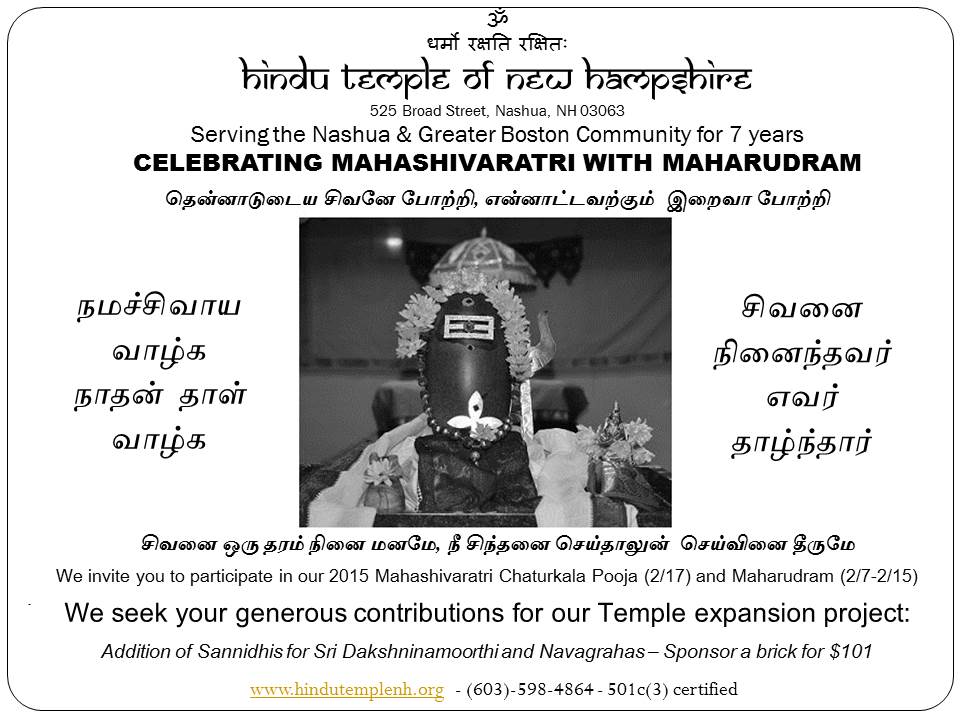
You may also access this article through our web-site http://www.lokvani.com/
